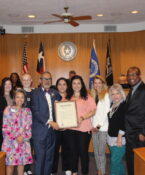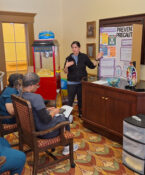Arbor Day: UNTHSC helping to protect environment
April 30 is Arbor Day, and the Health Science Center continues to do its part to protect the environment with activities ranging from the Living Legacy plantings as living tributes to installing a better light bulb.
The Living Legacy program allows donors to select a tree or other plants to be planted in honor of a special person or occasion, or to remember a lost loved one. The donors pay for the item(s) to be planted, help select the plant and location, and each planting is marked with an engraved granite plaque.
Last year, nine trees were added to the campus through the Living Legacy program – helping protect air quality and beautifying the grounds. The grounds keeping force cares for these plantings and all landscaping using earth-friendly Integrated Pest Management (IPM) techniques. IPM encourages careful monitoring of cultural practices, watering and maintenance to ensure the plants are as healthy as possible. This, in turn, saves water and minimizes the amount of herbicides and insecticides needed. For more information or to arrange a planting, visit the Living Legacy Web page.
In addition to the plantings, the former Osteopathic Medical Center of Texas parking garage will open next month with a state-of-the-art energy-saving lighting system. With the help the Health Science Center’s contractor, All Fair Electric, the garage’s 101 eight-foot fluorescent tubes, each requiring 144 watts of electricity, are being replaced with LED fixtures that require only 52 watts each, a 64 percent reduction. This prompted Oncor to grant the Health Science Center a one-time $13,000 energy rebate. The new lighting also is less costly to maintain.
The new Medical Education and Training Building is designed to achieve at least silver-level certification in the U.S. Green Building Council program. And an energy program completed in 2000 has reduced campus energy consumption by 47,285,390 kilowatt-hours and 548,132 ccf (100 cubic feet) of natural gas since the completion of the project. According to the Environmental Protection Agency, these savings reduced carbon dioxide emissions by about 364,343 tons, approximately equivalent to removing 72,869 cars from the road for one year or planting 99,101 acres of trees.





Social media